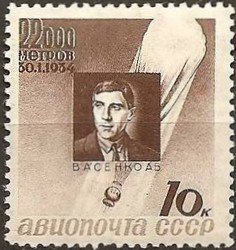Stamp: Andrey V. Vasenko (1899-January 30, 1934) (Soviet Union, USSR 1934)
Andrey V. Vasenko (1899-January 30, 1934) (Soviet Union, USSR 1934)
15 September (Soviet Union, USSR ) within release Stratosphere Balloon Disaster Victims goes into circulation Stamp Andrey V. Vasenko (1899-January 30, 1934) face value 10 Russian kopek
| Stamp Andrey V. Vasenko (1899-January 30, 1934) in catalogues | |
|---|---|
| Michel: | Mi:SU 481A |
Stamp is vertical format.
Also in the issue Stratosphere Balloon Disaster Victims:
- Stamp - Ilya D. Usyskin (1910-January 30, 1934) face value 5;
- Stamp - Andrey V. Vasenko (1899-January 30, 1934) face value 10;
- Stamp - Pavel O. Fedosenko (1898-January 30, 1934) face value 20;
Stamp Andrey V. Vasenko (1899-January 30, 1934) it reflects the thematic directions:
Famous People refers to the fame and public attention accorded by the mass media to individuals or groups or, occasionally, animals, but is usually applied to the persons or groups of people (celebrity couples, families, etc.) themselves who receive such a status of fame and attention. Celebrity status is often associated with wealth (commonly referred to as fame and fortune), while fame often provides opportunities to make money.
A hot air balloon is a lighter-than-air aircraft consisting of a bag, called an envelope, which contains heated air. Suspended beneath is a gondola or wicker basket (in some long-distance or high-altitude balloons, a capsule), which carries passengers and a source of heat, in most cases an open flame caused by burning liquid propane. The heated air inside the envelope makes it buoyant, since it has a lower density than the colder air outside the envelope. As with all aircraft, hot air balloons cannot fly beyond the atmosphere. The envelope does not have to be sealed at the bottom, since the air inside the envelope is at about the same pressure as the surrounding air. In modern sport balloons the envelope is generally made from nylon fabric, and the inlet of the balloon (closest to the burner flame) is made from a fire-resistant material such as Nomex. Modern balloons have been made in many shapes, such as rocket ships and the shapes of various commercial products, though the traditional shape is used for most non-commercial and many commercial applications.
The hot air balloon is the first successful human-carrying flight technology. The first untethered manned hot air balloon flight in the world was performed in Paris, France, by Jean-François Pilâtre de Rozier and François Laurent d'Arlandes on November 21, 1783, in a balloon created by the Montgolfier brothers. The first hot air balloon flown in the Americas was launched from the Walnut Street Jail in Philadelphia on January 9, 1793, by the French aeronaut Jean Pierre Blanchard. Hot air balloons that can be propelled through the air rather than simply drifting with the wind are known as thermal airships.


